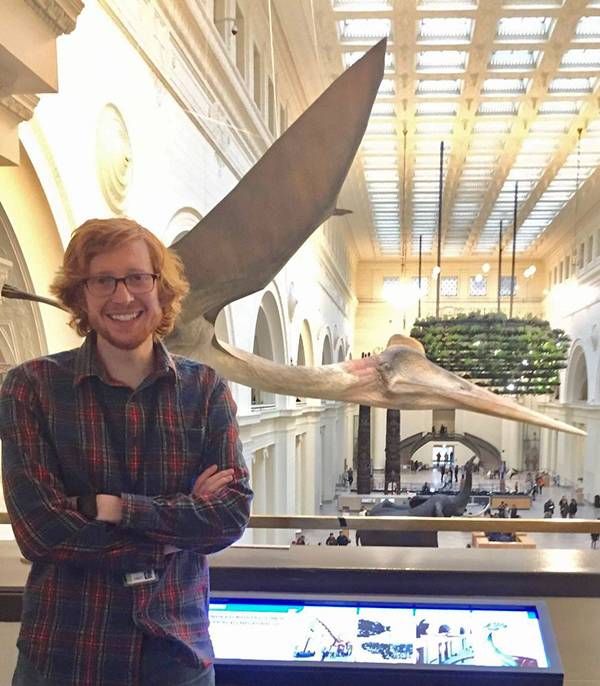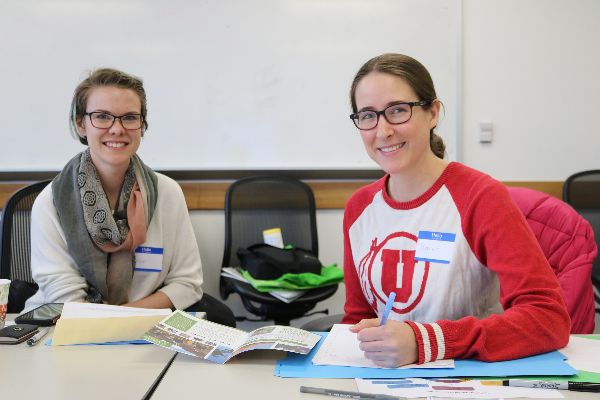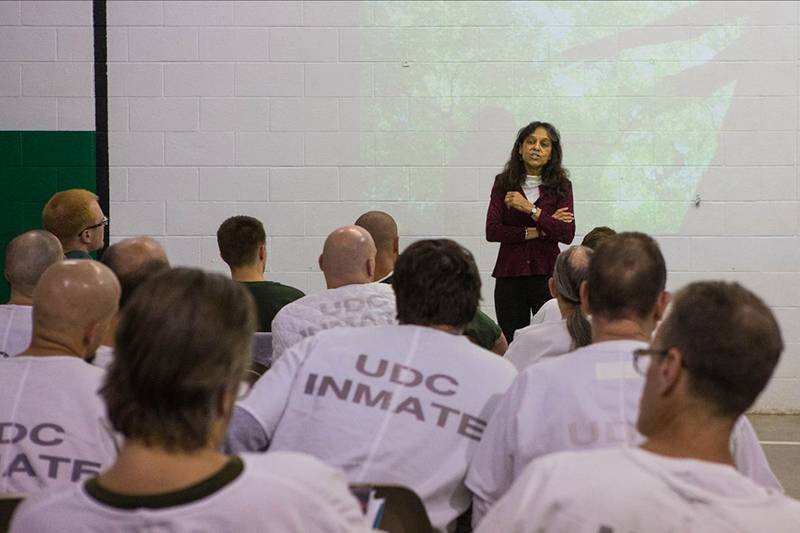Fall 2021 Newsletter

Letter From STEMAP Team
Dear STEM Ambassadors and Community Partners,
STEMAP is pleased to introduce our new Program Manager, Andrew George! Andrew comes to us from the Field Museum of Natural History in Chicago, and is looking forward to working with Ambassadors in our coming Spring cohort. We have a more thorough introduction of Andrew below.
This brings us to the next bit of news: we are excited to announce that the STEM Ambassador Program is recruiting scientists for our Spring 2022 University of Utah Cohort! We are accepting applications from graduate students, researchers, postdocs and faculty associated with the University of Utah until December 15th. The cohort training will begin in January and conclude in May.
Our sister program, INSPIRE, is looking for a Teaching and Learning Assistant for the Spring Semester. This paid position will be a facilitator for a new science exploration course at the Utah State Prison through the Utah Prison Education Project. You can find more information about the position and instructions for applying in the article below.
Finally, STEMAP is working with the Office of Research Education (REd) at the University of Utah to offer Broader Impacts support to grant-seeking faculty and researchers. This new partnership will involve one-day Broader Impacts workshops and one-on-one consultations for scientists at the university.
We are grateful for your continued support for public engagement of science and STEMAP’s work, and wish you very happy holidays!
Nalini M. Nadkarni
Director, STEM Ambassador Program
Andrew George
Program Manager
Meg Young
Program Coordinator
STEMAP Spring Cohort Application Live!

The STEM Ambassador Program (STEMAP) is recruiting University of Utah graduate students, post docs, staff, and faculty to participate in a training during the Spring semester. 2022 Applications are due on December 15, 2021. We invite you to share this opportunity with others in your lab, Department, or College.
STEMAP is directed by Dr. Nalini Nadkarni and funded by the National Science Foundation. Participants in the training participate in a series of five workshops and one-on-one meetings over a semester to design, implement, and evaluate a public engagement project. Engagement projects will take place outside traditional science learning venues such as museums, schools, and college campuses, to include people who cannot or do not engage with science in traditional science learning venues. Instead, they carry out events in community venues where public groups live, work, recreate, and worship.
STEMAP has trained over 150 Ambassadors from many disciplines, including engineering, biology, geology, math, anthropology, urban planning, and physics.
This upcoming training and all engagement projects will be conducted in accordance with University of Utah public health guidance (in-person or online). Participants will be notified of the location before the orientation workshop.
The application can be found on the STEMAP website, and here.
New STEMAP Program Manager: Welcome Andrew George!

This fall, the STEM Ambassador Program welcomed a new Program Manager, Andrew George. Originally from Georgia, Andrew comes to us from Chicago, IL, where he completed his PhD in Integrative Biology at the University of Chicago in June of 2020 and subsequently served as an NSF Postdoctoral Fellow at the Field Museum of Natural History. In these roles, Andrew studied the biomechanics and conservation biology of tropical fishes and applied what he learned in his research to the design and implementation of a variety of public education programs for children and adults.
Some of his favorite past engagement activities include curating hands-on, educational displays of local and invasive fish specimens for children through the Field Museum’s Dozin’ with The Dinos series, teaching middle school students how to employ multiple high speed video cameras to reconstruct insect flight paths in three dimensions through the Museum’s Teen Digital Learning Program, and designing interactive natural history educational activities for youth in custody through the University of Utah’s STEM Community Alliance Program.
In addition to public engagement, Andrew is passionate about college teaching and scientific mentorship. He values active, hands-on education practices and has enjoyed applying these teaching techniques to a variety of contexts such as incorporating artistic sketching activities while teaching art history museum studies students about natural history museum research and the important role that anatomical drawings and models have played in the history of the biological sciences. Andrew also enjoys hiking and camping and was excited to apply these interests to teaching a desert biology field course in the American Southwest in which he taught undergraduate students how to design and conduct insect ecology field studies in Organ Pipe Cactus National Monument, AZ.
As a biologist and community educator, Andrew is excited to join the STEM Ambassador Program team where he can help teach researchers to develop creative and inclusive programs of their own to facilitate the exchange of ideas between scientists and members of the public in accessible spaces. He’s also looking forward to learning from the diverse perspectives of the STEM community of graduate students, post-docs, faculty and staff at the U and our partner institutions.
In his short time at the U, Andrew has already enjoyed getting to know the STEMAP team and participating in the Fall Broader Impacts Workshop, where he was able to meet STEM faculty and students from across the university and discuss creative community engagement ideas. As an outdoor enthusiast, he looks forward to the unique trail running, biking and hiking access that Salt Lake City has to offer and hopes to pick up some new outdoor hobbies including skiing and fly fishing. Andrew plans to draw on these interests to complete a STEMAP engagement activity of his own this coming spring!
STEM Community Alliance Program Recruiting Speakers

The STEM Community Alliance Program (STEMCAP) provides science activities, workshops and conservation projects in a number of Youth-In-Custody facilities around the Salt Lake area, and is recruiting interested scientists to participate. Workshops have included topics including electrochemistry, wildlife management, botany, art and science, engineering, and more.
E-mail Laura George, the STEMCAP Program Manager, if you would like more information. You can apply to present with STEMCAP on the program website.
INSPIRE Recruiting TA for Spring Semester

The University of Utah Prison Education Project is a seeking a paid spring 2022 Teaching and Learning Assistant for a collaborative Science Right Now course exploring current STEM research.
This course will alternate between research scientist lectures and in-class assignments each week. The class will be held on Tuesdays at the Draper prison from 5-8 pm. This position will provide academic support throughout the semester, working directly with students at the prison, and assignment review and grading. Academic support includes assisting students with assignments and papers, and engaging in conversations related to class content. The TLA receives a $1,000 stipend.
Minimum Qualifications:
- Previous experience tutoring and confidence in STEM content areas.
- Current graduate student.
- Ability to read along with the class and understand/fully explain assignments for students.
- Meet Utah Department of Corrections requirements for becoming a volunteer.
- Attend all class sessions during the semester.
- Not hold any ill feelings or biases towards people with incarceration histories.
- Attend the UPEP orientation.
To apply: Please send a resume or CV and a brief cover letter explaining why you want to work for UPEP to upep@utah.edu by December 15th. Review of applications begins immediately. Questions can be directed to Laura George at laura.george@utah.edu.
For more information visit upep.utah.edu
STEMAP Partners with Office of Research Education
This fall, the STEM Ambassador Program ran its first one-day Broader Impacts workshop through the Office of Research Education (REd), giving an introduction to BI requirements and values for participants in the workshop. Program Director Nalini Nadkarni discussed the need for meaningful BI in National Science Foundation grant proposals. Following this, STEMAP staff led participants through the Connection Interview exercise, assisting researchers in identifying potential communities that would benefit from two-way exchange with the scientists and their work.
Following this workshop, STEMAP is pleased to begin offering one-on-one consultation opportunities for researchers looking for assistance with Broader Impacts sections of their grant proposals. STEMAP will also be offering another one-day workshop with REd in the spring.
Research publications about the STEM Ambassador Program
The core of the STEM Ambassador Program (STEMAP) has been to develop and provide trainings that help scientists forge and maintain relationships in community to engage effectively with public groups. In addition, however, the STEMAP team also participates in evaluation and research to help meet the challenges and answer questions in the field of informal science engagement. In November 2021, four STEMAP staff and advisors– Nalini Nadkarni, Caitlin Weber, John Besley, and Sue Allen — served as co-authors for a research paper about research-practice partnerships, an area of growing interest in this field. Below is the abstract and citation for this article.
Abstract: This paper is the culmination of several meaning-making activities between an external researcher, PES practitioners, and social scientist researchers who considered the unique contributions that can be made through RPPs on PES (that is, research-practice partnerships on public engagement with science). Based on the experiences from three RPP projects, the group noted that the PES context may be particularly suited to RPPs, and identified the importance of working as thinking-partners who support reciprocal decision-making. Recommendations are made in support of using these approaches to advance practical knowledge-building and reduce shared frustrations about the disconnect between research and practice in PES.
Citation: Peterman, K., S. Garlick, J. Besley, S. Allen, K.F. Lambert, N. M. Nadkarni, M. S. Rosin, C. Weber, M. Weiss and J. Wong. https://doi.org/10.22323/2.20070801 2021. Boundary spanners and thinking partners: adapting and expanding the research-practice partnership literature for public engagement with science (PES). Journal of Science Communication 20:7:1-16. DOI: https://doi.org/10.22323/2.20070801
Articles about STEMAP that have appeared in other peer-reviewed journals are:
Nadkarni, N. M., C. Q. Weber, S. V. Goldman, D. L. Schatz, S. Allen, and R. Menlove. 2019. Beyond the deficit model: the Ambassador Approach to public engagement. BioScience 69:305–313.
Weber, C.Q., S. Allen, and N. M. Nadkarni. Scaling training to support scientists to engage with the public in non-traditional
venues. Journal of Science Communication. 20(4):
https://doi.org/10.22323/2.20040802
Stylinski, C., C. Weber, and N. Nadkarni. In press. Prevalence of discourse on public engagement with science in ecology literature. Frontiers in Ecology and the Environment.
About the Blog
Discussion channel for insightful chat about our events, news, and activities.
Categories
Featured Posts
Tag Cloud
- UoG (2)
- Guam (2)
- ethnobotany (1)
- environmental policy (1)
- student immersion (1)
- engineering (1)
- Virgin Islands (1)
- USVI (2)
- lionfish (1)
- children's home (1)
- conservation (1)
- marine ecology (1)
- youth (1)
- sustainability (2)
- Utah (1)
- Arizona (1)
- Nevada (1)
- southwest (1)
- virtual (1)
- project management (1)
- training (1)
- naturalist (1)
- forest (1)
- ecosystem (1)
- Puerto Rico (1)
- Spanish (1)
- library (1)
- Huntington's (1)
- medical science (1)
- Emmanuel Ngwoke (1)
